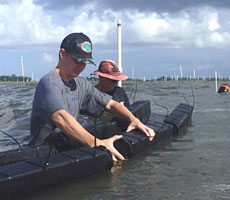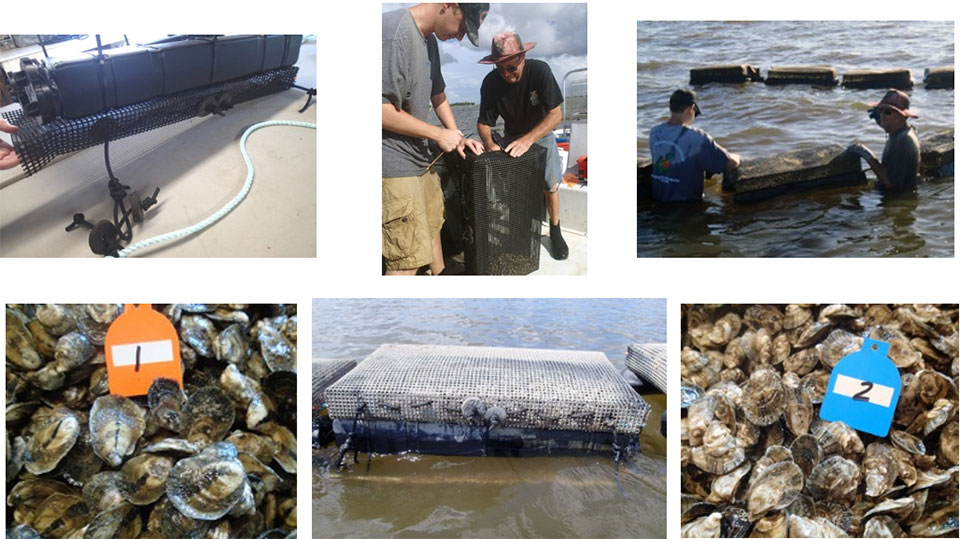Triploid and diploid oyster stocks were also planted by UF at their experimental lease located within the Dog Island Lease Area off Cedar Key on August 4, 2016. Detailed information will be collected to document practices (for example, biofouling control, bag transfers), production, and labor. Approximately 5000 seed of each ploidy type were placed into four 9 mm square mesh Vexar bags, resulting in a stocking density of 1250 oysters per bag with volumes per bag averaging 4.0 liters for triploids (3N) and 3.5 liters for diploids (2N). Shell measurements were similar for both ploidy stocks (26 mm, or 1”, shell height [SH]), but total weights differed (3N, 2.5 grams; 2N, 1.9 grams). Samples of juvenile oysters were sent to Dr. Laramore to test for the presence of Dermo, an oyster parasite. Prevalence and intensity were 0% for both ploidy types.
 The gear type being used by UF to culture oysters is the floating bag. Two 4 ½” square floats are used to support a bag; bags are attached to a longline (1/2” poly rope) secured by screw anchors. Because the lease site is located in the open waters of the Gulf of Mexico and is affected by prevailing southeast winds during the summer, the bags are attached along their length (not width) to two “pucks” (2 ½” diameter rubber pieces resembling a doughnut) on the longline. In addition, two “pucks” are tied to 5/16” nylon braided rope, which is weaved the length of the bag to minimize possible ripping of the plastic bag meshes under adverse weather conditions (see pictures) After 25 days (August 29), oysters were measured to estimate growth. The average volume of triploid oysters per bag was 11.2 liters, while the volume of diploid oysters per bag was 8.75 liters. Triploid oysters averaged 40 mm (1.6”) SH and 8.1 grams, while diploid oysters averaged 37 mm (1.5”) and 5.6 grams. To control fouling, bags are flipped weekly and allowed to aerial dry for at least 6 hours. Very little fouling was noted during this time period, although a small barnacle set did occur.
The gear type being used by UF to culture oysters is the floating bag. Two 4 ½” square floats are used to support a bag; bags are attached to a longline (1/2” poly rope) secured by screw anchors. Because the lease site is located in the open waters of the Gulf of Mexico and is affected by prevailing southeast winds during the summer, the bags are attached along their length (not width) to two “pucks” (2 ½” diameter rubber pieces resembling a doughnut) on the longline. In addition, two “pucks” are tied to 5/16” nylon braided rope, which is weaved the length of the bag to minimize possible ripping of the plastic bag meshes under adverse weather conditions (see pictures) After 25 days (August 29), oysters were measured to estimate growth. The average volume of triploid oysters per bag was 11.2 liters, while the volume of diploid oysters per bag was 8.75 liters. Triploid oysters averaged 40 mm (1.6”) SH and 8.1 grams, while diploid oysters averaged 37 mm (1.5”) and 5.6 grams. To control fouling, bags are flipped weekly and allowed to aerial dry for at least 6 hours. Very little fouling was noted during this time period, although a small barnacle set did occur.




